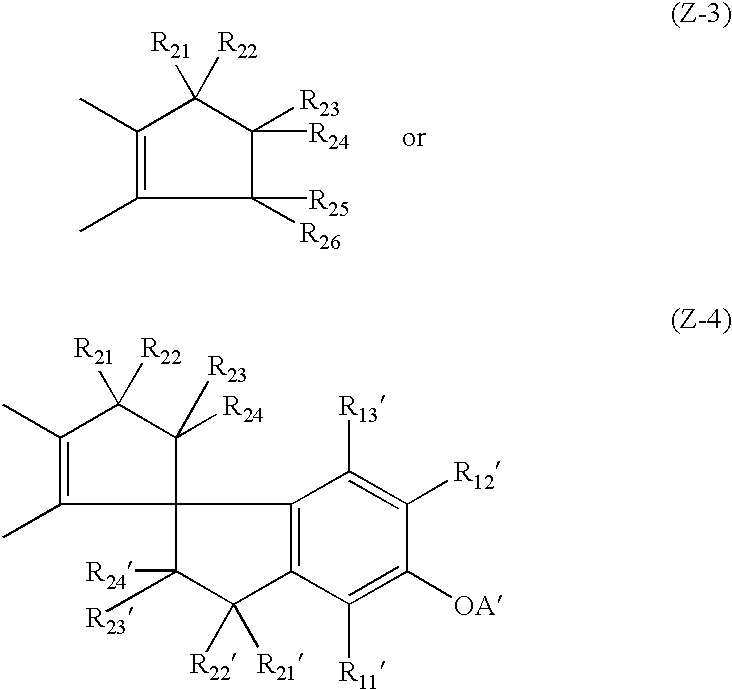Photothermographic material and method for making
a technology of photothermographic materials and materials, applied in the field of photothermographic materials, can solve the problems of low productivity of coating rate, difficulty in concurrent coating of multiple layers, and hazard including flammability and explosion
- Summary
- Abstract
- Description
- Claims
- Application Information
AI Technical Summary
Benefits of technology
Problems solved by technology
Method used
Image
Examples
example 1
(1) Preparation of Sample Nos. 102-120
Preparation of Silver Halide Grains
In 700 ml of water were dissolved 22 grams of phthalated gelatin and 30 mg of potassium bromide. The solution was adjusted to pH 5.0 at a temperature of 35.degree. C. To the solution, 159 ml of an aqueous solution containing 18.6 grams of silver nitrate and an aqueous solution containing potassium bromide and potassium iodide in a molar ratio of 92:8 were added over 10 minutes by a controlled double jet method while maintaining the solution at pAg 7.7. Then, 476 ml of an aqueous solution containing 55.4 grams of silver nitrate and an aqueous solution containing 9 .mu.mol / liter of dipotassium hexachloroiridate and 1 mol / liter of potassium bromide were added over 30 minutes by a controlled double jet method while maintaining the solution at pAg 7.7. The solution was then desalted by lowering its pH to cause flocculation and sedimentation. Phenoxyethanol, 0.1 gram, was added to the solution, which was adjusted to ...
example 2
Preparation of Silver Halide Grains
In 700 ml of water were dissolved 22 grams of phthalated gelatin and 30 mg of potassium bromide. The solution was adjusted to pH 5.0 at a temperature of 35.degree. C. To the solution, 159 ml of an aqueous solution containing 18.6 grams of silver nitrate and an aqueous solution containing potassium bromide and potassium iodide in a molar ratio of 92:8 were added over 10 minutes by a controlled double jet method while maintaining the solution at pAg 7.7. Then, 476 ml of an aqueous solution containing 55.4 grams of silver nitrate and an aqueous solution containing 6 .mu.mol / liter of dipotassium hexachloroiridate and 1 mol / liter of potassium bromide were added over 30 minutes by a controlled double jet method while maintaining the solution at pAg 7.7. The pH of the solution was lowered to cause flocculation and sedimentation for desalting. Phenoxyethanol, 0.1 gram, was added to the solution, which was adjusted to pH 5.9 and pAg 8.2. There were obtained...
example 3
Example 2 was repeated except that 10 ml of 5% methyl ethyl ketone solution of phthalazine and 18 ml of 10% methyl ethyl ketone solution of developing agent-1 were added instead of 10 grams of the water dispersion of phthalazine and developing agent-1. However, the photosensitive emulsion flocculated and sedimented during agitation.
Then, a coated sample was prepared by adding the methyl ethyl ketone solutions of phthalazine and developing agent-1 to the surface protective layer in an equivalent coverage per unit area to Example 2 rather than adding to the photosensitive layer. There was obtained a black image having a Dmin of 0.18 and a Dmax of 1.2 when measured by sensitometry as in Example 2.
PUM
| Property | Measurement | Unit |
|---|---|---|
| temperature | aaaaa | aaaaa |
| particle size | aaaaa | aaaaa |
| particle size | aaaaa | aaaaa |
Abstract
Description
Claims
Application Information
 Login to View More
Login to View More - R&D
- Intellectual Property
- Life Sciences
- Materials
- Tech Scout
- Unparalleled Data Quality
- Higher Quality Content
- 60% Fewer Hallucinations
Browse by: Latest US Patents, China's latest patents, Technical Efficacy Thesaurus, Application Domain, Technology Topic, Popular Technical Reports.
© 2025 PatSnap. All rights reserved.Legal|Privacy policy|Modern Slavery Act Transparency Statement|Sitemap|About US| Contact US: help@patsnap.com



